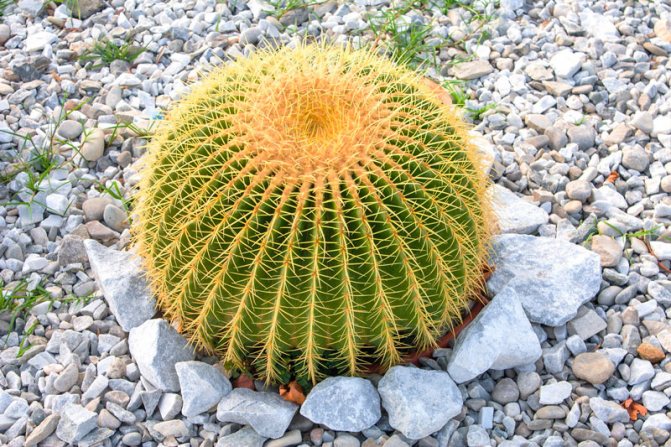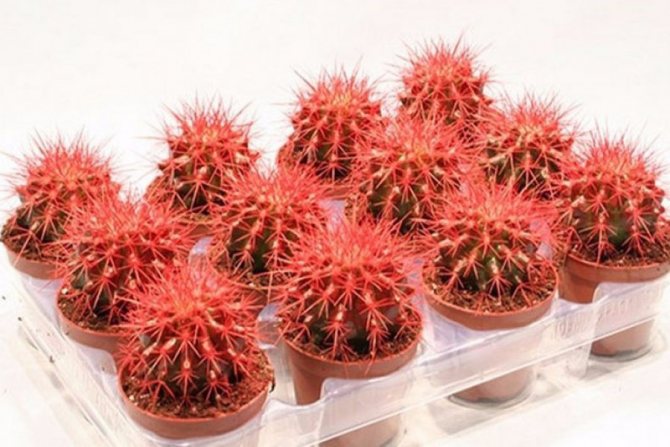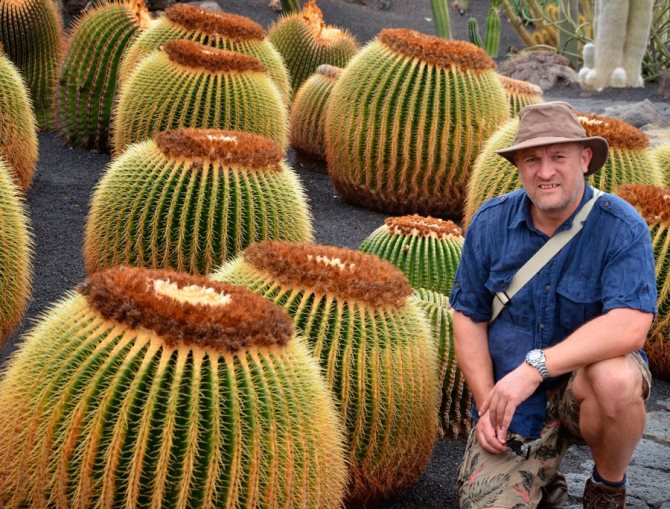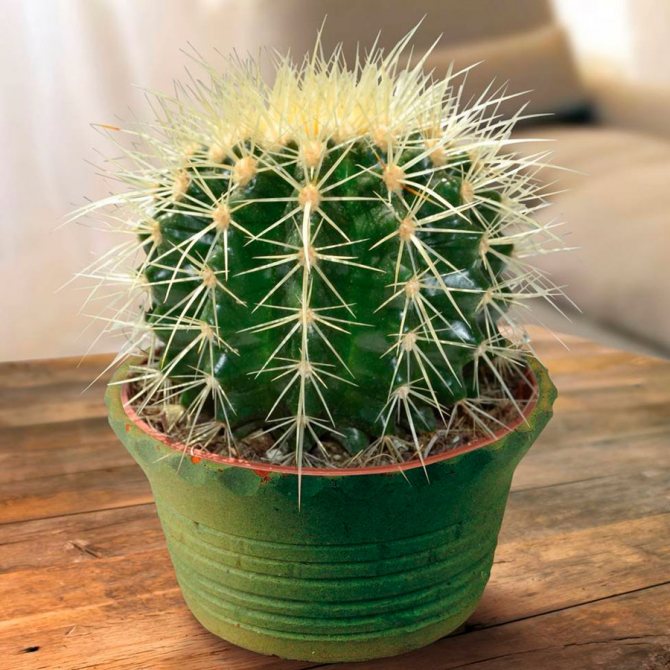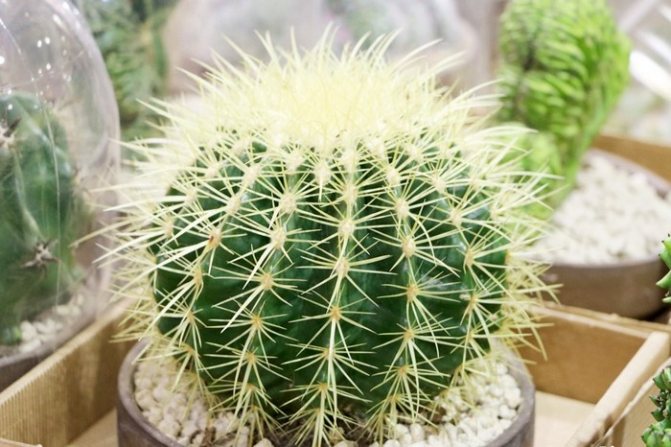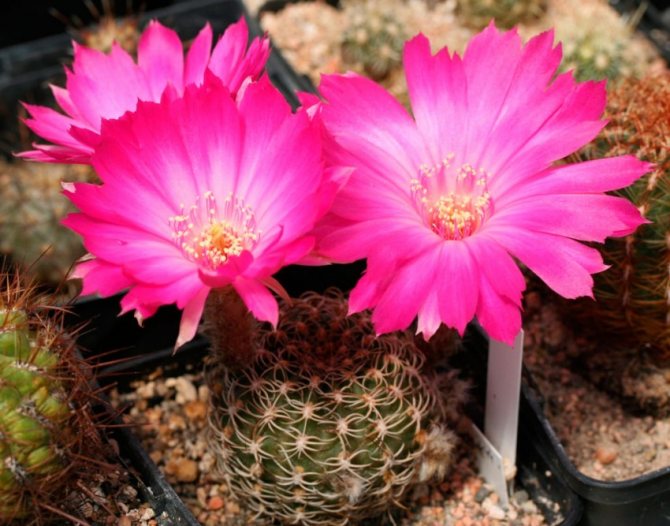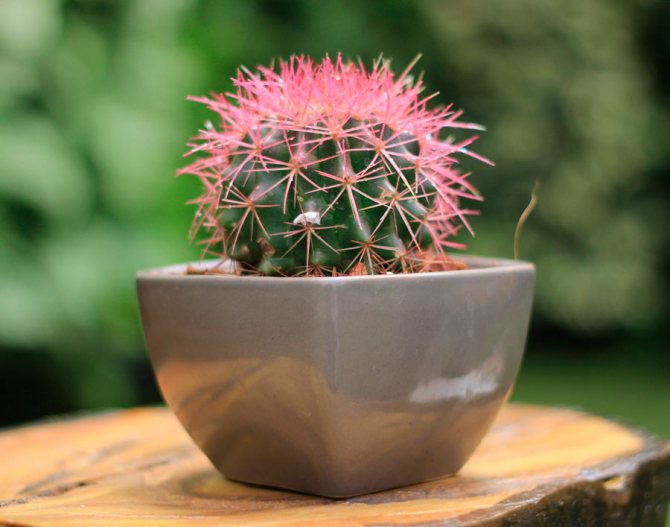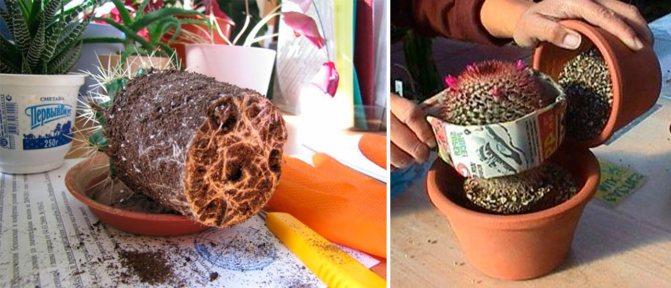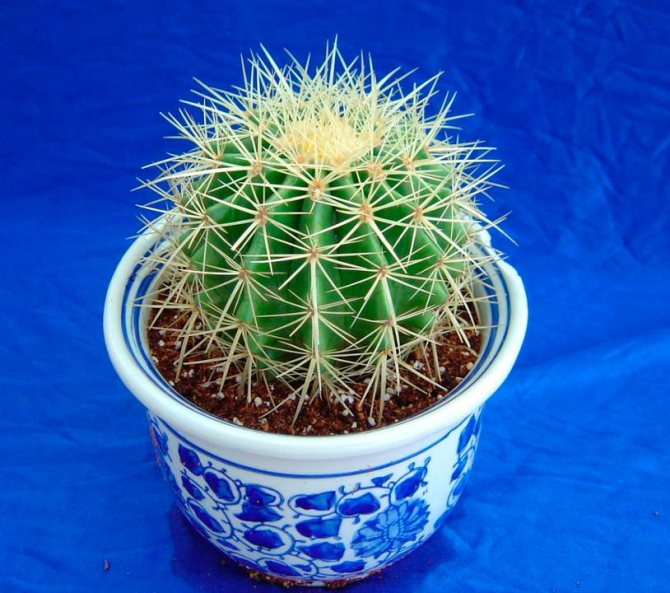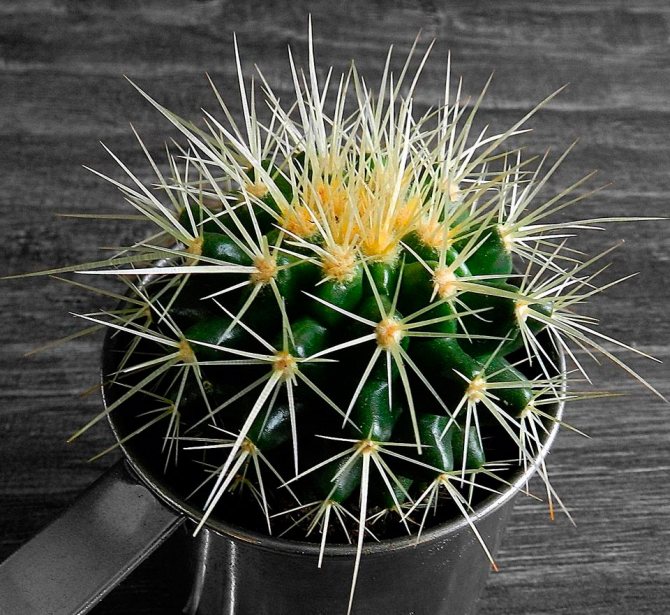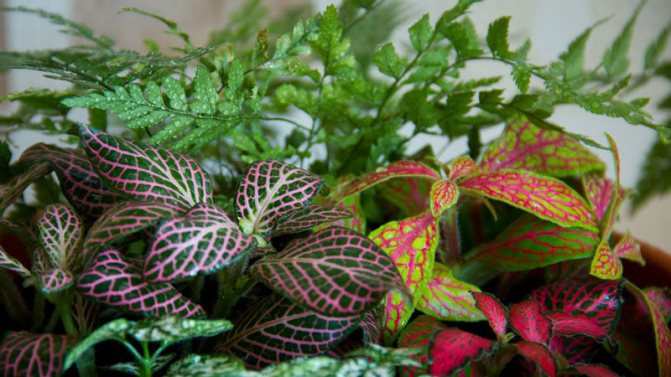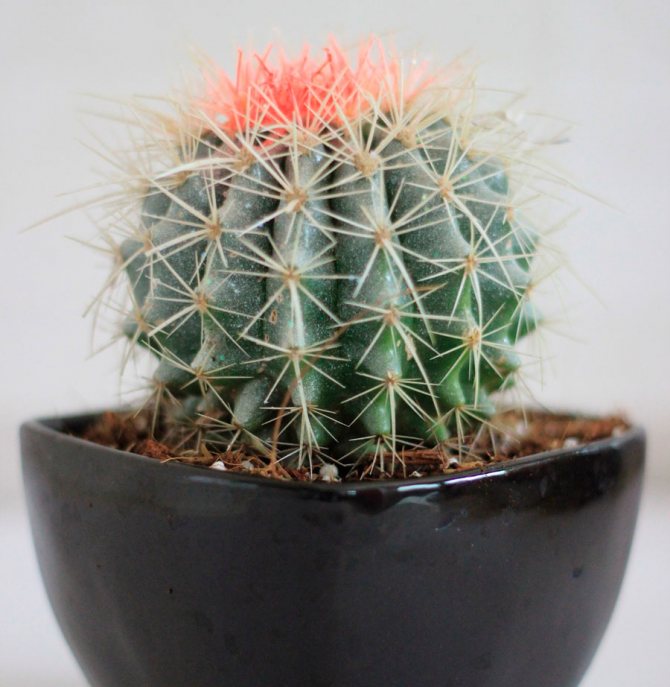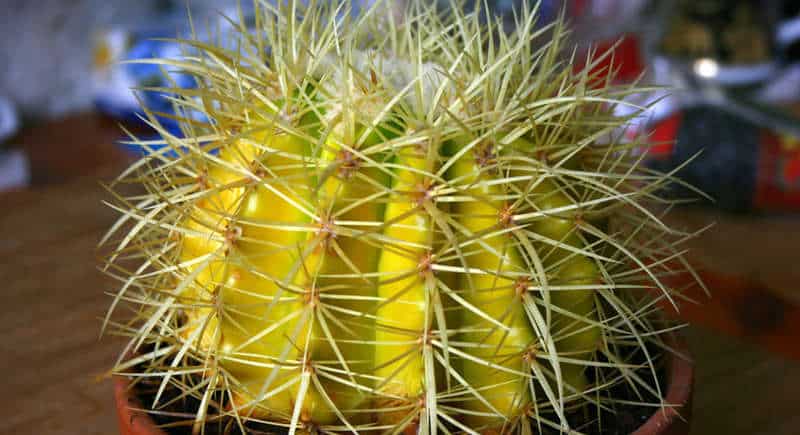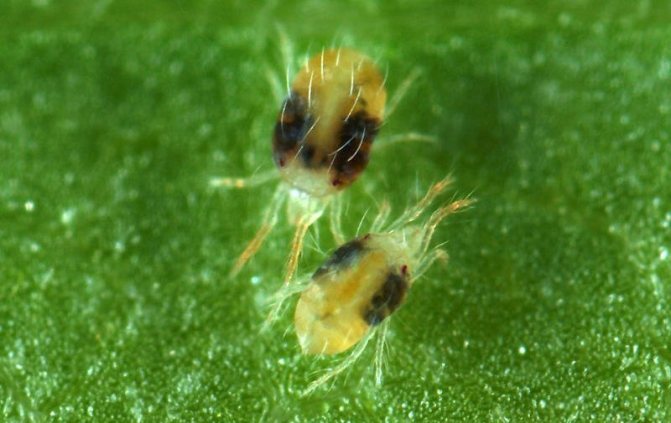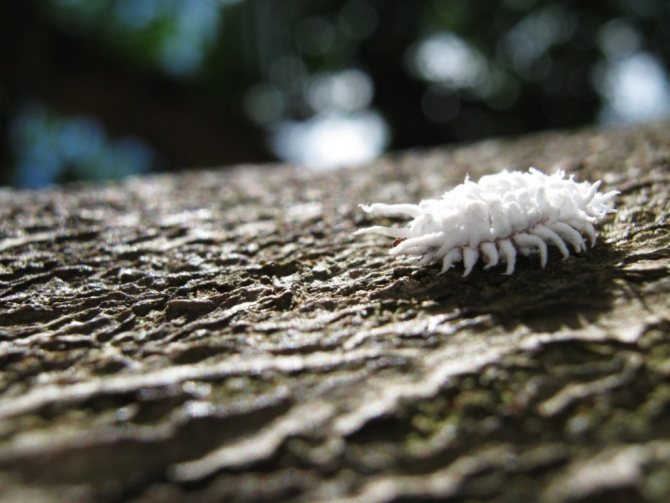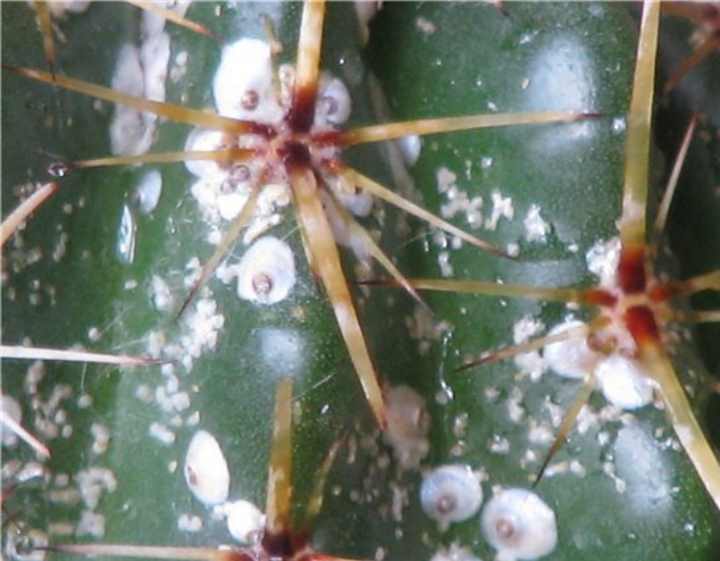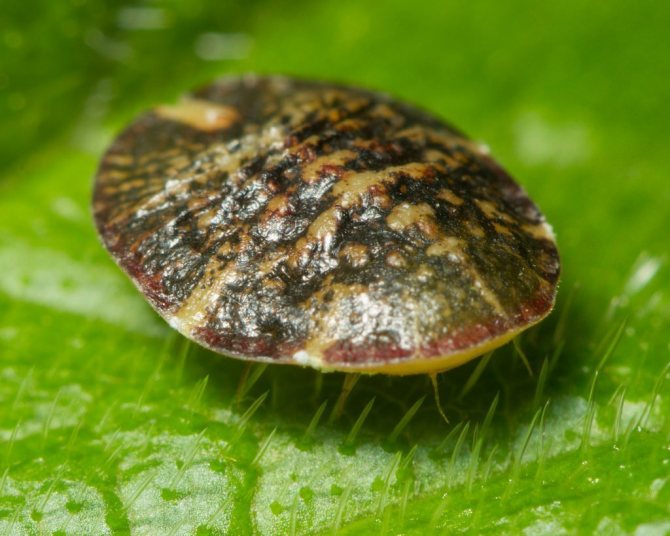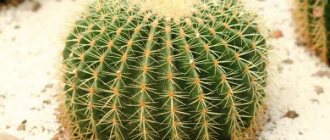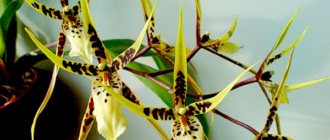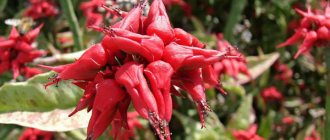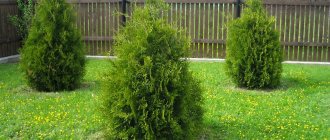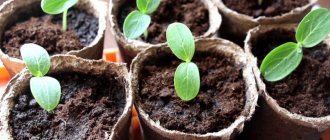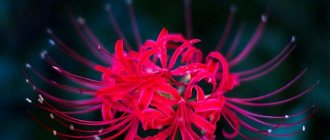The succulent echinocactus looks like a hedgehog curled up in a ball. From Greek echinos and translated as "hedgehog". The cactus has an almost perfect spherical shape and differs from other species in its large size.
The homeland of echinocactus is the deserts of America, where plants up to 3 meters in diameter are found. It adapts well to room conditions, especially if the rules of care are followed.
Types of echinocactus
In nature, there are only 6 species of hedgehog cactus, outwardly unlike each other.
Echinocactus grusonii
In Mexico, this type of echinocactus is on the verge of extinction. It grows in natural conditions on rocky heights at an altitude of more than a kilometer above sea level. Named after the compatriot of the discoverer of the species - Herman Gruzoni. It was first described by the botanist Heinrich Hildmann.
Echinocactus gruzoni has the shape of a ball, flattened on top. In adult plants, the surface is formed by ribbed projections covered with straight thorns.
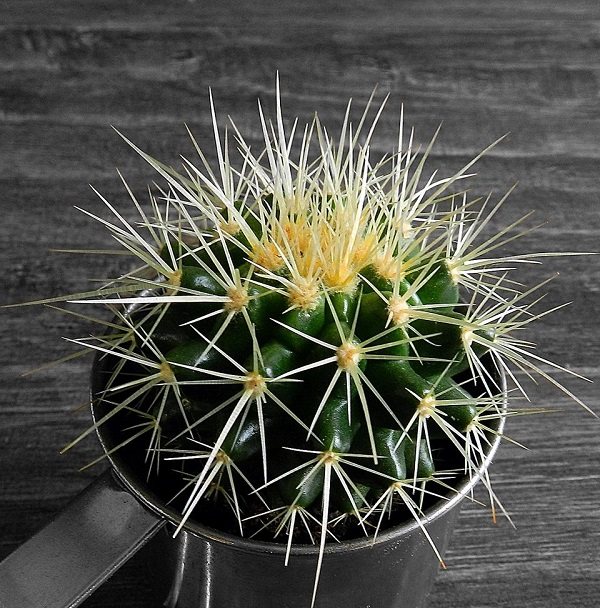
The body of the plant is dark green, the spines are brownish-yellow or white. In stores, you can see artificially bred varieties with red (red weight) or yellow (rainbow weight) thorns, distinguished by their brightness and originality.
The life span of a cactus is more than 30 years, when it reaches a meter in diameter. In this case, flowering begins no earlier than at the age of 20.
Echinocactus platyacanthus (Echinocactus platyacanthus)
The flat-spiked cactus also grows in Mexico, in the Chihuahua Desert. For local residents, it is edible, it is used to prepare traditional sweets.
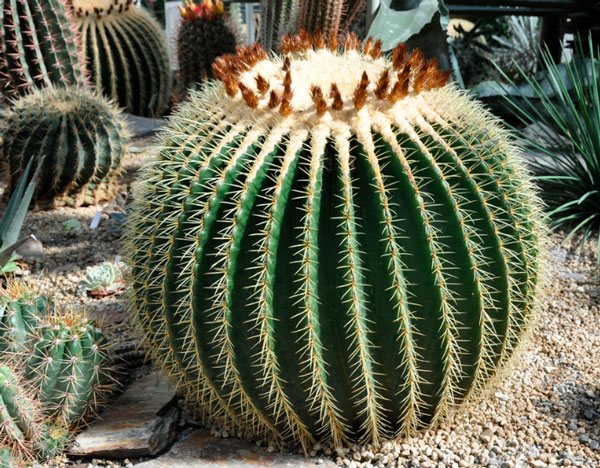

The shape of the trunk can be either round or cylindrical up to 2 meters in height. The color of pronounced furrows is gray-green, and the spines are red or brown. The top is flat with a soft surface on which flowers are formed.
Echinocactus parry (Echinocactus parryi)
A short cactus has a flattened trunk up to 30 cm in height. Long spines are concentrated in bundles along the edges of pronounced ribs, behind which the body is almost completely hidden. The body is khaki-colored, the spines are brown, and the funnel-shaped flowers are yellow-white.
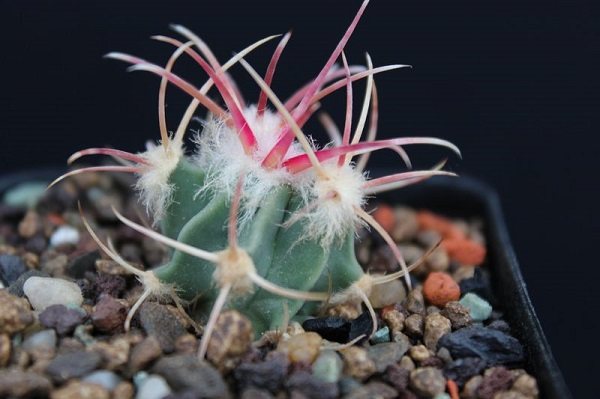

Echinocactus horizontal (Echinocactus horizonthalonius)
It grows on almost bare stones in the form of blue-green cylindrical plants 20 by 45 cm. The trunk is divided into segments, twisting in a spiral. Large pink-red flowers up to 10 cm in diameter bloom in June and have a pronounced daily cycle (they open during the day and hide at night).
View this post on Instagram
Posted by Lucy (@ lu.cy8329) Nov 21, 2020 7:07 am PST
Echinocactus wide-spined
The wide-spined echinocactus grows up to one and a half meters in height. The ribs are even larger than those of the weight (up to 50 pieces). They have brown spines up to 3 cm long.
The difference from other species is the strongly pubescent top, on which yellow funnel-shaped flowers bloom.
Echinocactus polycephalus (Echinocactus polycephalus)
The most arid regions of the Mojave and Sonoran deserts are considered the homeland of the multi-headed cactus. Named for its ability to form clusters of 30 specimens.
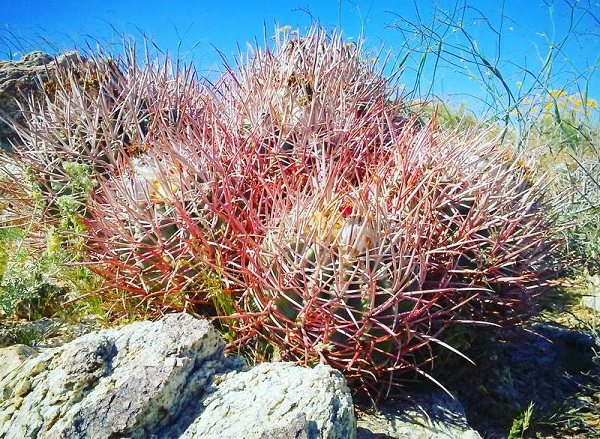

Each plant individually reaches half a meter.The trunk is densely covered with long spines.
The main color of the spines is brown, but after rare rains they acquire a crimson color.
Botanical description
The rainbow echinocactus from the Cactus family grows up to 1 m in height and up to 1 m in width in their natural environment. The homeland of growth is the desert area of Mexico and the Southwest of the United States of America. This popular plant attracts with its slow growth rate and high decorative qualities, it should be planted indoors not only because of the flowers, but because of its interesting spherical shape with numerous pink thorns.
"Hedgehog cactus" - as the locals also call Gruzoni - grows in nature up to 200-500 years. As it matures, its spherical shape transforms into a barrel-shaped one. But the changes concern not only the shape: at the age of 3-4 years, sharp ribs with dense sharp needles are formed from small tubercles. First, a "fluff" appears on the growing upper part - young spines that have not yet become coarse.
This type of cactus grows in the form of a spherical stem with sharp edges that are in an upright position. There are 35 to 45 of them. The glossy surface of the stem attracts attention with its pronounced green color.
The original spines are formed from the areoles located on the ribs of the hedgehog cactus. In each of them, radial needles (10 pieces) and central (1-4 pieces) are formed. In length, they do not exceed 3-5 cm, and the radial ones are smaller from the central ones. The decorativeness of Gruzoni lies in the presence of a kind of "cap", consisting of young needles, formed at the top. The thorns can be white or yellow - a natural color. If on the market there are Echinocactus Gruzoni with spines of red, green, bright yellow color, then the cultivation takes place with the use of dyes. Such a marketing move subsequently has a detrimental effect on the state of the plant itself: it begins to hurt and in most cases dies.
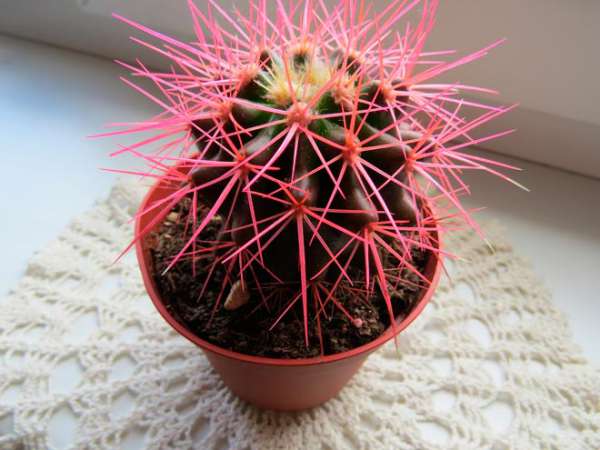

In indoor conditions, an exotic culture in height and in diameter rarely exceeds 40 cm. You can observe flowering only when the plant reaches 20 years old. The blooming phase of beautiful flowers occurs in May-June. The first to form a bud on a long stem, and already from it - a yellow flower. The funnel-shaped tube is covered with fluff on the outside, the thin petals are distinguished by a glossy surface. They have a brown border around the edges. The length of the corolla of the flower is 7 cm, the diameter is 5 cm.
Echinocactus bloom
Flowering echinocactus gruson will reward only very patient growers. After all, the maturity of a cactus in the form of the ability to reproduce and form seeds occurs at the age of 20 years. And even after such a long time, under unfavorable conditions, the buds may not appear.
Advice! If you buy an adult specimen and take proper care of it, you will be able to see the flowers earlier.
The upcoming flowering is evidenced by the appearance of protrusions at the top of the ball. From them buds bloom in the shape of a funnel, the color depends on the species. The grungy is characterized by bright yellow flowers with thin and elongated petals, they are located around the circumference of the flattened top.
View this post on Instagram
Publication from Tamara Vouk (@vouktamara) Mar 13, 2020 12:46 pm PDT
Growing conditions
Creating optimal conditions for growing a cactus will allow you to have a beautiful healthy plant that delights those around you with its appearance.
Temperature and humidity
It is important to remember that at temperatures above +30 ° C, the growth of this type of cactus slows down or may even stop. For the period from October to February, it is advisable to keep the echinocactus in a cooler room. The optimum temperature for him during this period is + 12 ° C.
For the normal development of Echinocactus Gruzoni, direct sunlight is needed. In the summer it can be taken out in the open sun.In insufficient light, the plant loses its thorns.
If the echinocactus is always turned towards the light with one side, then the shaded side gradually shrinks, the appearance of the cactus deteriorates. To avoid this, the cactus pot must be periodically turned in the same direction, for example, clockwise.
As a soil for echinocactus Gruzoni, it is reasonable to use ready-made soil for cacti, sold in flower shops. In this case, it is advisable to add fine gravel or brick chips to this soil.
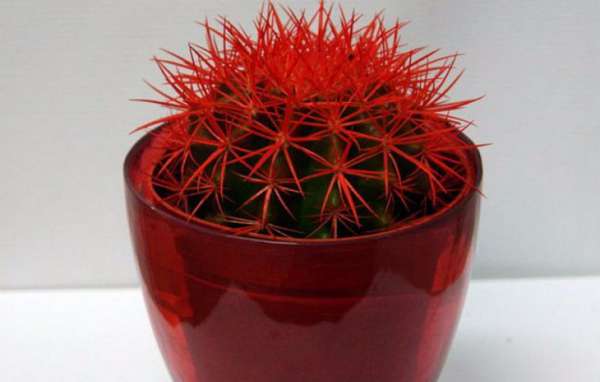

How to care for echinocactus gruzoni
Home care is similar to most desert varieties of succulents.
The types of grubs are most popular among flower growers for the best adaptation to home conditions among all representatives of echinocactus.
Lighting
Deserts, where cacti grow in nature, are characterized by an abundance of sunlight and long daylight hours. A similar lighting mode must be created in room conditions.
It is better to place the plant on a windowsill in the southern or adjacent side of the apartment. At noon, the cactus should be shaded from the hot sun.
Important! If echinocactus has been in partial shade for a long time (for example, on a store shelf), then it must be gradually taught to the bright sun. For this, the time spent under bright rays is increased daily by 1 hour.
Temperature
Echinocactus feels comfortable at a temperature of 20 ... 25 ° C. In the summer heat, when the thermometer is above 30 6C for a long time, the plant stops metabolic processes and goes into a state of dormancy. It is not recommended to allow this, it is better to remove the pot in partial shade or take it outside without access to the sun.
View this post on Instagram
Post by VV (@ vv28taf) Aug 5, 2020 11:47 am PDT
Temperatures below 12 ° C are severe stress for the succulent. Brown spots will appear on it, it will lose its decorative appeal. The cactus is not able to withstand even minimal frost, this must be taken into account when growing on the site. If the plant is not returned to the apartment in time, it will die.
Watering
In watering succulents, there is a rule: it is better to arrange a short drought than waterlogging the soil. There is enough pulp in the trunk of the cactus to withstand the lack of moisture. But constant moisture contributes to the decay and death of the plant.
Once again watered the next day after 2/3 of the soil dries. In the summer this happens 1-2 times a week, and in the winter, during the dormant period, watering may not be required at all.
View this post on Instagram
Publication from tillandsia odessa (@tillandsia_odessa) Aug 16, 2019 10:14 am PDT
Moisten the soil either early in the morning or overnight to prevent scalding from the hot sun. The cactus does not need spraying, it is enough to wash off the dust from it 1-2 times a month under a warm shower.
The soil
For echinocactus, a very porous soil with a slightly acidic environment is preferable; most of the substrate should not be earth, but sand or other breathable materials.
In the garden departments of shops it is easy to find ready-made cactus soil, balanced in composition. For better growth, you can additionally add fine drainage or gravel (a quarter of the volume) to it and mix well.
Pot selection
The pot is selected from any material, the main thing is to match the size of the plant. Since the echinocactus has a spherical shape, the container needs a wide one. The diameter of the pot should be 5-7 cm larger than the cactus. This will be enough for growth, but will prevent stagnation of excess moisture and the appearance of diseases.
The depth is also needed more than the height of the cactus. It is important to consider that it will take about 3–5 cm of the height of the pot for the drainage layer.
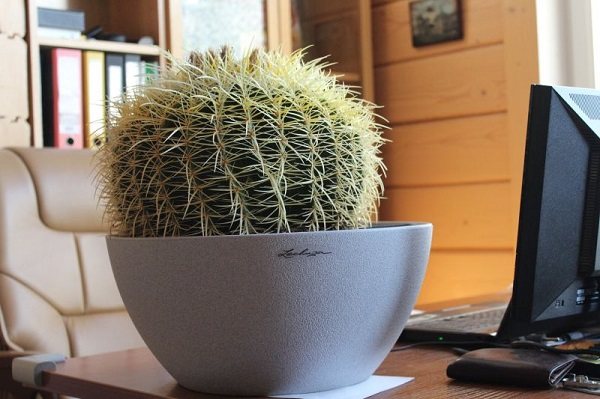

Due to the slow growth, the initial capacity will last a long time for the cactus. Even during transplanting, they often do not take a larger pot, but only renew the fertile substrate.
Planting and transplanting
When transplanting, the soil is renewed for nutritious and the roots of the cactus are examined. This is usually done in the spring when returning to active growth after wintering. Young plants require an annual transplant. In this case, the pot can be changed only once every 3-5 years for a larger one.
In no case should the roots be damaged, as they are very sensitive to any influence. After pulling out of the pot, the old soil is slightly shaken off, the plant is covered with a new substrate.
The nuances of the transplant after purchase:
- When planting in open ground, a hole is dug, twice the volume of the roots. The distance to the neighboring plant is not less than the double circumference of the cactus trunk.
- A drainage layer is needed not only at the bottom of the pot, but also on top of the soil 1–2 cm thick.
- The soil is slightly pressed down during the transplanting process.
- At the end, the soil is poured abundantly with warm water.
Caution! Echinocactus spines are very sharp, the transplant is carried out with thick gloves for gardening.
When and how it blooms
Thuja in the Urals - planting and care at home
Only with good care can you see how Gruzoni's echinocactus blooms. This happens around the age of 20.
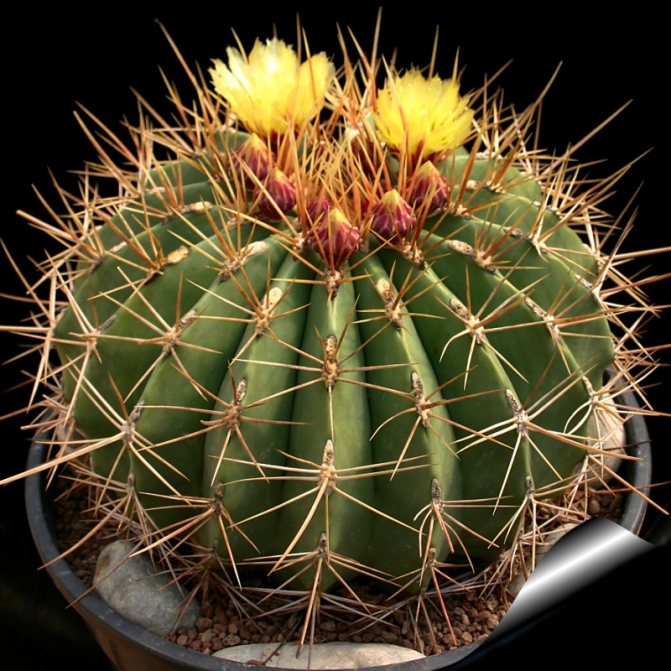

How echinocactus Gruzoni blooms
Types of flowers
Flowers bloom one by one. They are up to 6 cm long. They are located in a wreath at the top of the stem.
Flower shapes
They have a short tomentose flower tube. Corolla bright lemon with multiple and narrow petals.
Flowering period
Echinocactus blooms only in the summer months.
Changes in care during flowering
How to care for echinocactus during flowering? You do not need to make any changes to the standard content. It is only necessary to avoid getting drops on the buds.
Diseases and pests
If you follow the listed rules on how to care for echinocactus, then the disease is not terrible for him. One of the main causes of diseases in succulents is systematic waterlogging of the soil. To eliminate any problem, the first priority is to reduce watering.
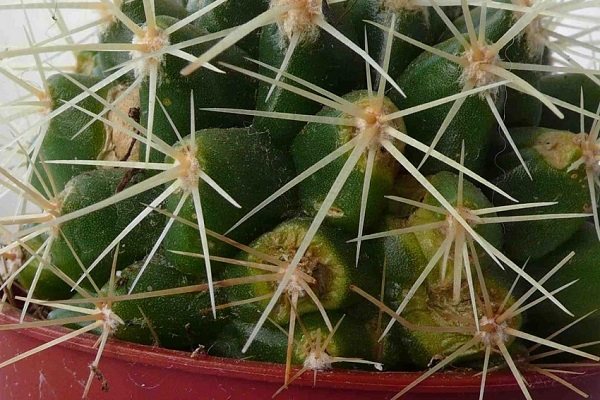

Shield
It manifests itself as a brown coating or spots on the trunk or thorns. The pests themselves live in them, the plaque is easily separated from the surface. For treatment, the affected areas are treated with cotton wool dipped in alcohol. Another option is spraying with an insecticidal solution.
Cactus mite
Almost invisible arthropods also appear on the echinocactus with brown specks. To solve the problem, you will need an acaricidal preparation with which the plant is treated twice with an interval of a week.
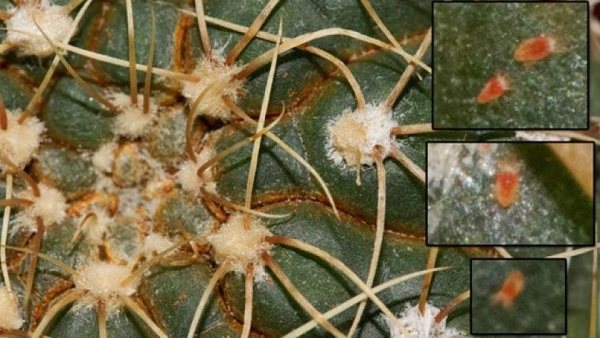

Scorms
Worms cause a milky bloom around the thorns. An early sign is a darkening of the trunk, this is a signal that the roots are damaged by a pest. To combat parasites, the cactus is washed under the shower, and then daily treated with soapy water and alcohol.
Care rules
Echinocactus Gruzoni is unpretentious, but improper care of it can cause a deterioration in the appearance of the plant, or even lead to its death.
For watering a cactus, water is used that has settled for 3-4 days at room temperature. During the active growing season (spring-summer), water the plant infrequently, waiting for the soil to dry completely in the pot. From the middle of autumn, watering is reduced, and in winter, watering is usually done without watering.
As a top dressing for echinocactus, Gruzoni uses special fertilizers for cacti, any other fertilizers can do more harm than good. For example, any organic matter is categorically contraindicated for cacti.
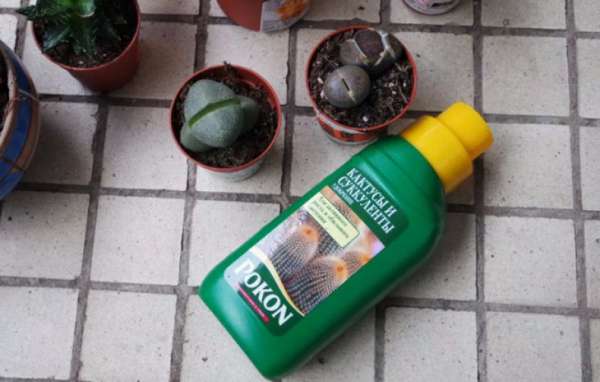

Top dressing is done once a month and only in the spring-summer period, starting in mid-spring and ending in early autumn.
As it grows, the plant is transplanted into larger pots.Pot size is defined as the diameter of the cactus plus one to two centimeters. Transplanting a cactus is fraught with difficulties due to the many needles.
The plant removed from the pot should be inspected and, if necessary, rotted or dried roots removed. The cactus can be watered no earlier than 2-3 days after transplanting.
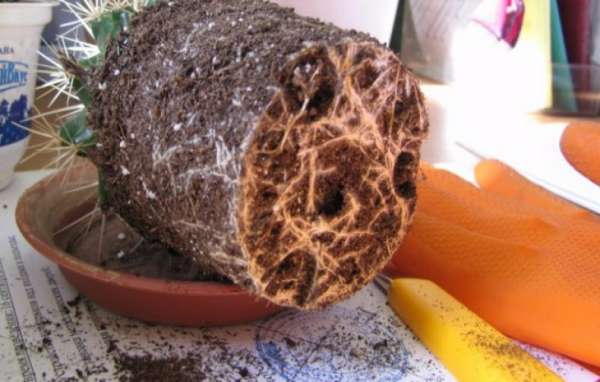

Reproduction
Echinocactus can only be propagated in adulthood, when it is capable of flowering.
Seeds
In place of flowers, boxes with small brown seeds are formed. They are carefully removed and placed in water overnight. For germination, you need a shallow tray covered with a mixture of peat, vermiculite and sand (6: 4: 4).
The seeds, together with water, are drawn into a syringe and distributed over the surface of the substrate. From above, the pallet is covered with foil or glass. The emergence of seedlings is expected in 1–1.5 months.
They are transplanted into separate containers (no more than 5 cm in diameter) with tweezers after the appearance of thorns. Further growth continues for 1–2 years, and the sprout is able to withstand transplantation into a larger pot (up to 10 cm).
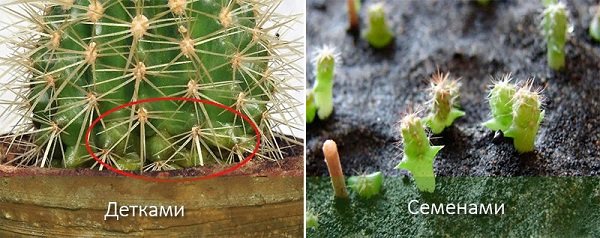

Children
Vegetative reproduction is not typical for echinocactus. Babies can form only in places where the succulent is damaged by disease or mechanical means. As a result, the mother plant may soon die. If there are signs of dying off of the main trunk, you need to separate the daughter cactus and plant it separately.
Transfer
Step by step process:
- Put expanded clay drainage in a new pot (with a layer of 1-2 cm), pour in a little soil mixture.
- Wrap a wire or thick cloth around the stem of the cactus so as not to injure your hands.
- Remove the plant from the old container, place it in a new one so that the roots touch the bottom, but do not bend.
- Fill the voids with earth, tamping it down a little.
- Cover the root collar with sand, sprinkle with a little water.
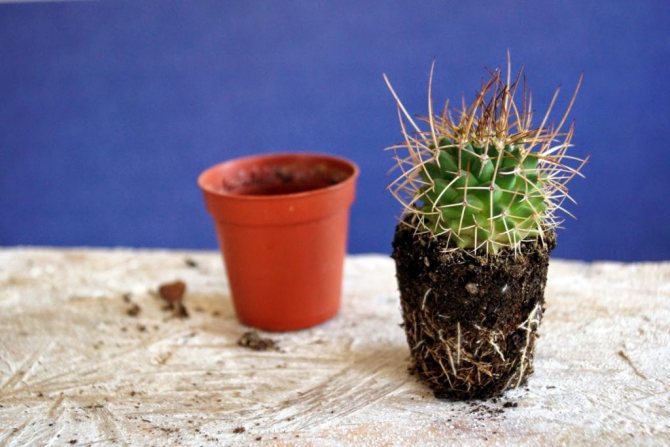

Adult specimens are transplanted together with an earthen clod.
Features of choice when buying
A large number of echinocactus species are on sale.
Often novice cactus lovers meet in stores Echinocactus Gruzoni with bright colored thorns, the names of which have the names "Echinocactus Gruzoni Red" or "Echinocactus Gruzoni Rainbow".
In reality, there are no such varieties of cactus., it's just that the thorns are painted in the appropriate colors with food dyes - respectively, in red or in several bright shades at once. You can buy such cacti almost without fear, because it is worth taking care of the red echinocactus of the grungy or the Rainbow in the same way as for the usual one, you just need to pay attention to the fact that dyes can negatively affect the plant, therefore, if possible, you need to try to wash them off.


